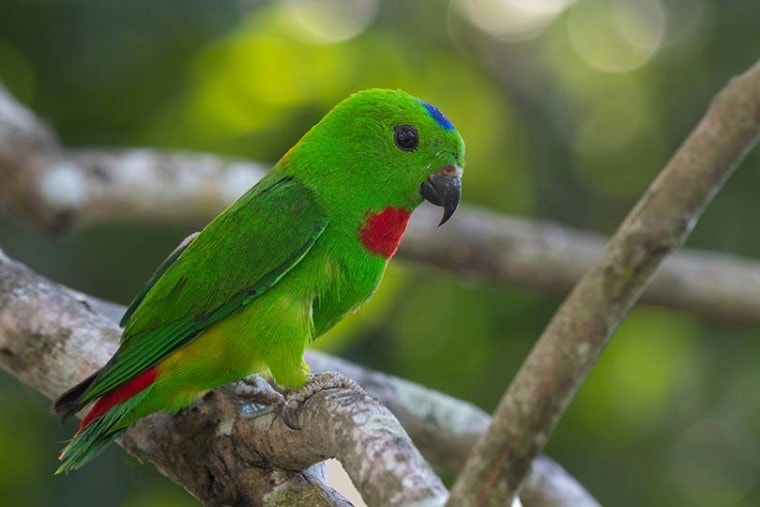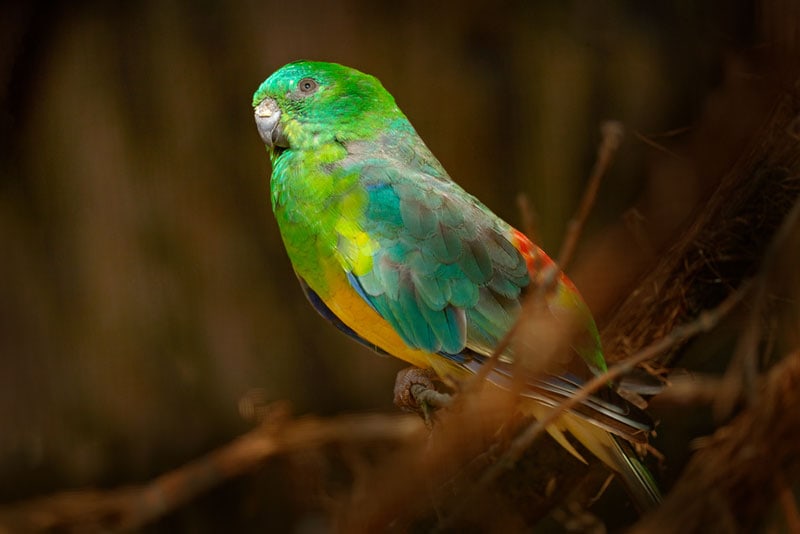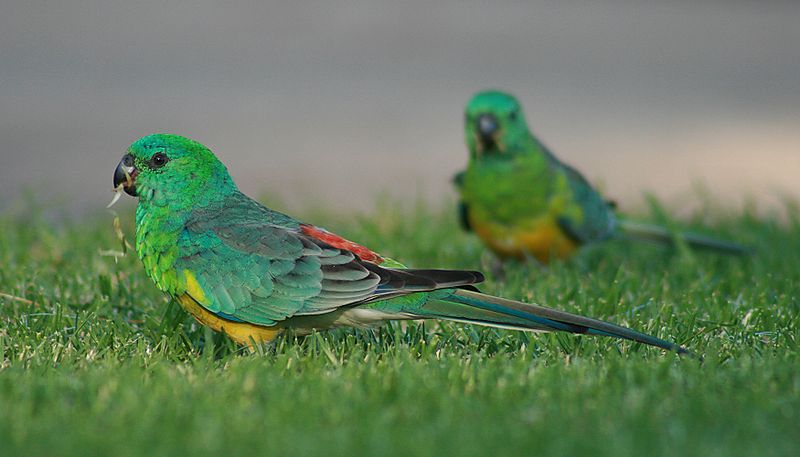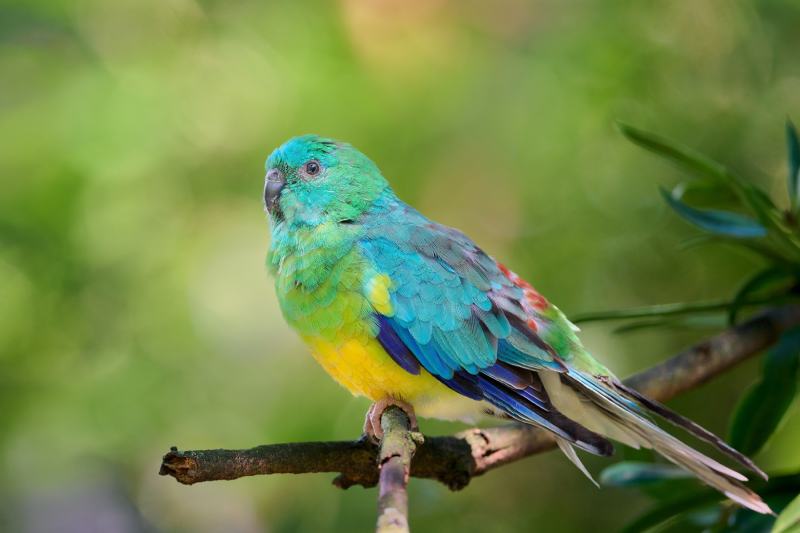
Parakeets are one of the most popular pet birds in America. They’re not only beautiful, but they can be affectionate and entertaining to watch as well. Red Rump Parakeets are native to Australia, and their personality traits differ from other types of parrots, such as African Grey Parrots or Macaws.
This blog post will cover everything you need to know about this unique bird: what they eat, how often they need to bathe, etc., so you can make sure your new companion thrives!
Species Overview

| Common Names: | Red-Backed Parrot, Grass Parrot |
| Scientific Name: | Psephotus haematonotus |
| Adult Size: | 10–12 inches |
| Life Expectancy: | 15–30 years |
Origin and History
The first Red Rump parakeets were found in New South Wales, Australia. They’re from Australia and have lived there for thousands of years. They’re considered a protected native species of Australia. For this reason, although you can own a Red Rump Parakeet in Australia,1 you can’t capture them from the wild or export them to another country.
The Japanese bred red Rump Parakeets in Japan for more than 40 years. They became popular pets because they’re much smaller than other parakeet breeds – so they’re suitable for living in apartments with limited space. Japanese breeders also focused on producing Red Rump parakeets with blue feathers, which is why these birds are sometimes referred to as “blue-eared” parrots instead of Red Rump ones.
The original Japanese stock used to produce Blue-Eared parakeets was taken out of the wild, so today, this bird may become an endangered species. However, newer parakeet breeding programs have been established in other countries such as the US and Australia.
These countries breed the birds for their beauty and sell them to pet owners aware of Red Rump parakeets’ conservation status and choose not to purchase birds from other countries where they’re collected from the wild.

Temperament
Red Rumps are very loving, playful, and energetic birds. They’re generally good-natured, delightful to observe, and a delight for anyone who chooses one as their pet! If you’re thinking about purchasing one of these colorful creatures, be prepared to have a lot of fun watching them interact with your family members and other pets you may already own. However, there are a few facts that novice owners should know when it comes to this particular type of parrot:
Despite being small parrots, Red Rumps may not be as easy to train as some other types of smaller species, such as budgies or cockatiels. In fact, they can be pretty tricky. If you don’t take the time to train them early on, you can run into many behavioral issues later in life. They’re also very sensitive and may become depressed when left alone for long periods or if they’re handled by people who aren’t gentle.
Red rump parakeets are prone to plucking their feathers if they have a lot of excess energy. If this happens, you must give your pet plenty of activities to expend his extra energy throughout the day. This will help him avoid boredom and keep him from getting too distressed. Even though Red Rumps need lots of attention, they’re not as needy as other types of parrots, such as cockatoos – which is why some owners prefer them!
Speech & Vocalizations
Red Rump parakeets are known for their sweet songs! These birds have a wide variety of vocalizations but don’t expect your bird to repeat “I love you” back to you every time you whisper it to him. They can learn how to talk if you’re patient and spend lots of time training them with positive reinforcement – but keep in mind that this process can be complicated.
If you want a parrot who can speak, perhaps one of the other types might suit you better. However, if all you want is a beautiful talking companion with an endearing personality, then this species would do quite well in your family!
Normal vocalization for parakeets is chirping and squeaking, but most Red Rump parakeets love to whistle as well. They typically learn how when they’re young from their parents, so if you purchase one who’s already an adult, it might not be able to sing.
Red Rump Parakeet Colors and Markings

The male Red Rump is mostly bright emerald green with a big blue patch around his eyes and a bright orange beak. He’ll also have Red Rump feathers on the very tip of his tail as well as a few other places (typically only one or two). The female parakeet is usually just as gorgeous, but her colors are slightly duller with some yellow instead of green sprinkled in.
Both male and female birds have similar beaks, eyes, and legs. It can be difficult to tell them apart if they’re not in breeding season! The only difference is that the females’ faces are slightly lighter than the males’.
Caring for the Red Rump Parakeet
If you decide that a red-rumped parakeet is a pet for you, you need to prepare certain aspects of pet ownership—first things first: the cage.
A male Red Rump parakeet needs a cage at least 24″ by 24″ to feel comfortable. If you have more than one male bird, you’ll need to double the size of the cage. Females need a similar amount of space, but they can live together in a smaller enclosure if they’re housed separately from males.
Pet owners who decide to purchase and take care of this species will be happy to know that Red Rumps are quite clean pets. They don’t throw their food around, and they don’t poop all over their cage. They’re also fastidious about grooming and cleaning themselves but can be messy with water – which is something to keep in mind if you have a smaller cage! Male birds are known for being loud and screaming throughout the day, so if your goal has a quiet pet who never has any noise issues, then it’s best not to get one of these birds – unless you want a challenge!

Common Health Problems
There are many risks to consider when deciding to purchase a parrot, and the biggest one is the bird’s health. Fortunately, this species isn’t affected by as many illnesses as some of its larger cousins. Still, there are some things to watch out for.
The best way to prevent these illnesses or treat them early on is to keep your bird happy and healthy – which means proper diet, exercise, and enrichment. It’s also important to get a bird that is at least two years old. Older parakeets are typically healthier and have better personalities than younger birds because they’ve had a chance to grow up in a proper environment.
Diet and Nutrition
The parakeet’s diet consists of pellets made for birds mixed with some fruits and seeds. They shouldn’t have too many treats due to the high-fat content, so it’s best not to give them anything outside their needs.
They are small birds, so they don’t need much food (about 2 tablespoons per serving). However, it’s important to keep the nutrition up because if your parakeet is unwell, then it may not want to eat as much due to pain or lack of appetite. If this happens, you can mix some warm water with seed and offer it to him in a small dish.
If you’d like more information on feeding your pet, talk to a local veterinarian or breeder that has experience raising this species of bird.
Exercise
Even though Red Rump parakeets are smaller birds, they still need plenty of exercises! It’s best to keep their wings trimmed so that they don’t fly out of the cage. If you have a large enough room, open your bird’s cage door and watch him run around for about 20 minutes per day. If you live in an apartment, then put your bird’s cage near a window and let him zoom around the room!
Birds are species that like to chew, so it’s best not to leave anything small and breakable than he could accidentally swallow. It would be best if you also got some pet toys, especially ones with bells attached, as they’ll help keep your bird occupied and challenged.
You should give your pet some time to play on his own, especially if you’ve got plenty of room. If he’s flying around on his own, then it means that he isn’t getting enough mental stimulation from what you’re doing with him – which can cause various behavioral issues later on.

Where to Adopt or Buy a Red Rump Parakeet
As these birds aren’t as common in the pet trade, you need to make sure that you research and find a good breeder. You can sometimes find one by word of mouth – especially if someone’s been looking for a Red Rump parakeet locally and has found a breeder near their home!
If you want to buy from a breeder, then make sure that they have proper facilities – especially if you’re looking to get a pair of young birds. It would help if you also asked them questions about the area where they got your bird from (breeding location and other members of his flock), what vaccines he’s had, and how old he was when he came into their care. If you get a younger bird, then make sure that the breeder gives you a health guarantee and has a history of successfully breeding parakeets.
If you want to adopt your bird instead of buying one, several shelters in town have birds up for adoption. Go ahead and talk to an employee about what kind of bird would be best for your home and personality, and go from there. Not only are you saving a life by adopting an animal from a shelter, but you’re also getting to know your bird’s temperament before you bring him home.
Conclusion
In conclusion, the Red Rump parakeet is a wonderful pet for people who want more than just your average bird. This species has many positive qualities, including being easy to care for and playful. However, you must do some research before making this decision as there are certain requirements to keep these birds happy and healthy.
If you have any questions or concerns about owning one of these beautiful creatures, please contact us. Our team specializes in caring for all types of animals, from cats and dogs to exotic pets like the Red Rump parakeet!
Featured Image Credit: Norjipin Saidi, Shutterstock







